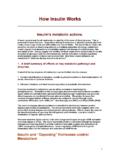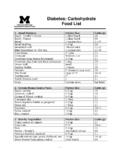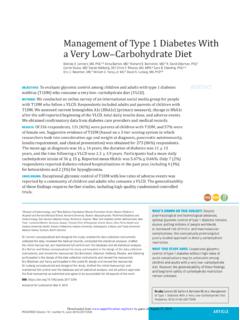Transcription of Carbohydrate metabolism - MedBio
1 Carbohydrate metabolism The metabolism of the sugars found in our food is discussed in all textbooks and I will not take up all of the details here. The points I do wish to discuss are concerned with maintenance of blood sugar levels under differing physiological conditions. How do we start up storage of glucose after a meal? How do we preserve blood glucose levels between meals? What are the differences in metabolism of common sugars in various organs? Transport of Glucose in and out of the Liver The whole thing begins with transport of sugars over tissue membranes.
2 These "small" sugars (glucose, fructose and galactose) are so large that they cannot cross cell membranes without "carriers". Sugar carriers are proteins embedded in the cell's outer membrane that provide transport systems for monosaccharides. The glucose transport protein family (called GLUT) is discussed elsewhere in MedBio . Click here for more information. The point to note now is that these carriers are bidirectional; they can transport glucose both into and out of cells. The direction of movement is determined by the concentrations of glucose in and outside of the liver cell.
3 This is illustrated in the figure above. 1 Drawing "1" shows the situation when the portal blood and the liver cell have equal concentrations of glucose; sugar moves in both directions simultaneously. This may seem to be wasteful, but gears the system to react to small changes in glucose concentration. The second drawing shows what happens when blood glucose tends to fall. Glucose production in the liver accelerates and the net flow of glucose is outward, stabilizing the blood sugar level. This is extremely important. The total amount of sugar present in the blood can support resting activity for about 40 minutes.
4 Just walking increases glucose use to a point where the entire blood content is used up in about 15 minutes. Since mental activity is completely dependent upon stable blood glucose levels, there must be a way of evening out blood glucose levels. This is one of the major duties of the liver. On a short-term basis, this is the only organ capable of replacing blood sugar used by other organs. Click here for the details. Following a meal, the portal blood sugar level increases. This is shown in the third drawing where we see that the liver rapidly takes up glucose from the blood.
5 Once again, the liver stabilizes blood sugar. In principle, this two-way flow of glucose can forego in most tissues. However, only the liver and kidneys are sugar producers and export of glucose occurs only in these tissues. Most of our organs are sugar-burners, taking up glucose from the blood and using it for energy production. What determines this limit on release of glucose from most of the body? Why cannot skeletal muscles release glucose from their large glycogen stores? The secret is that uptake of sugars to our organs involves immediate phosphorylation at either carbon 1 or 6.
6 The phosphorylated sugar derivatives cannot "leak" out of the cell. There is no mechanism for their cross-membrane transport. Once sugars are phosphorylated they stay put! What is the key to production of glucose in the liver and kidneys? These organs produce a specific enzyme, glucose-6-phosphatase, that cleaves the glucose-phosphate bond. Regulation of the balance between phosphorylating and dephosphorylating enzymes is crucial and determines the net direction of uptake and release of glucose in these organs. 2 Regulation of sugar phosphorylation As stated above, monosaccharides enter metabolism through phosphorylation.
7 That is, they react with ATP and a kinase to yield phosphorylated derivatives. Those small structural differences we noted between the three monosaccharides found in our food determine which enzyme initiates sugar metabolism . Glucose can be phosphorylated by either hexokinase or glucokinase. The former is involved in the cell's energy metabolism . Glucokinase is implicated in either energy storage or in glucose-signaling systems. Fructose metabolism is initiated metabolism . through fructokinase while galactokinase is the first enzyme involved in galactose 3 All organs exhibit hexokinase activity.
8 As the name implies, this enzyme is relatively nonspecific and can react with most 6-carbon sugars. However, its affinity for these sugars varies with their structure. Hexokinase reacts strongly with glucose at levels found in plasma and tissues. While it in principle can catalyze phosphorylation of fructose and galactose, its affinity for these is quite low. This excludes active handling of fructose and galactose by hexokinase at the concentrations of these found in our bodies. Hexokinase is product-inhibited. That is, if the glucose-6-phosphate formed by the enzyme is not rapidly removed, hexokinase activity promptly falls.
9 Hexokinase is well-adapted as the first enzyme in tissues utilizing glucose as an energy source, but not as the initiator of energy storage in the liver. We find, therefore, specialized kinases in the liver to handle all three of the sugars found in food. The following table summarizes the distribution and substrate specificity of the kinases involved in the initiation of sugar metabolism . Note that glucokinase is found in tissues that require a "glucose sensing system". I'll come back to this under a discussion of insulin secretion. Note also that it is the liver that has fructokinase and galactokinase activityliver is the only organ that actively metabolizes these sugars.
10 I will take up. The replacing table sugar with fructose later but you can see now that fructose is a e tively substrate for hepatic metabolism alone. Aside from sperm, no other organ has an active fructokinase. No other organ is perfused with concentrations of fructoslarge enough to allow reaction with hexokinase. The liver very effecremoves absorbed fructose from the portal blood. In fact, this is necessary for uptake of fructose in the gut. Remember that transport there is passive, relying on a steep concentration gradient to drive fructose uptake.









